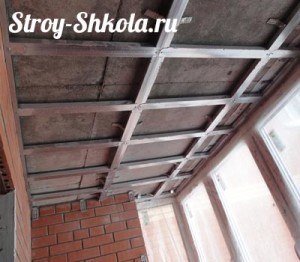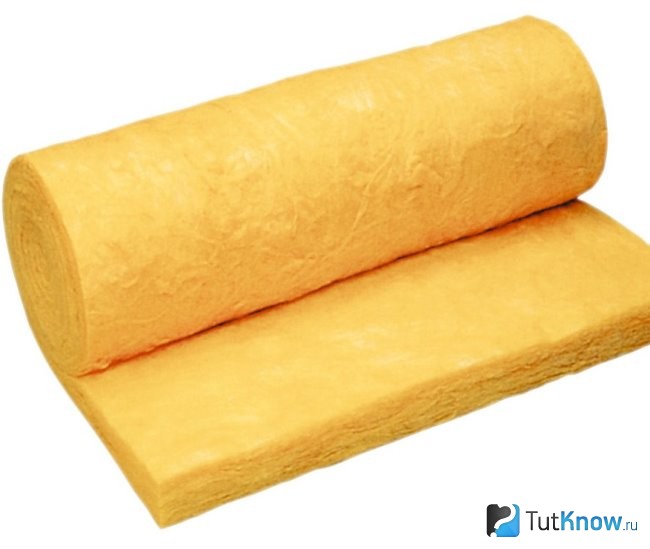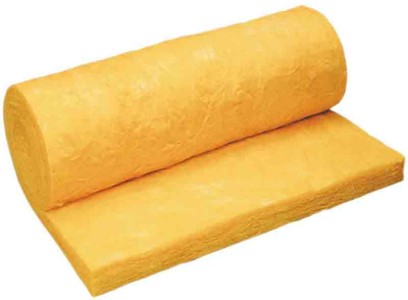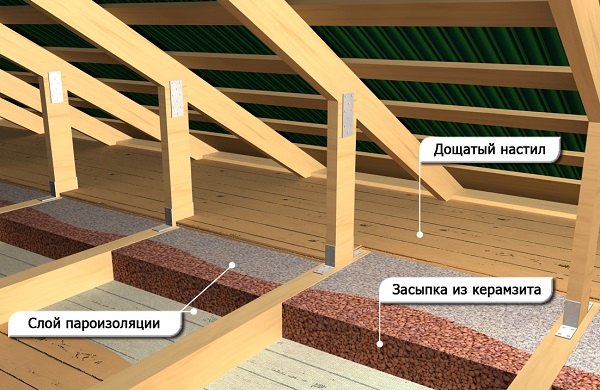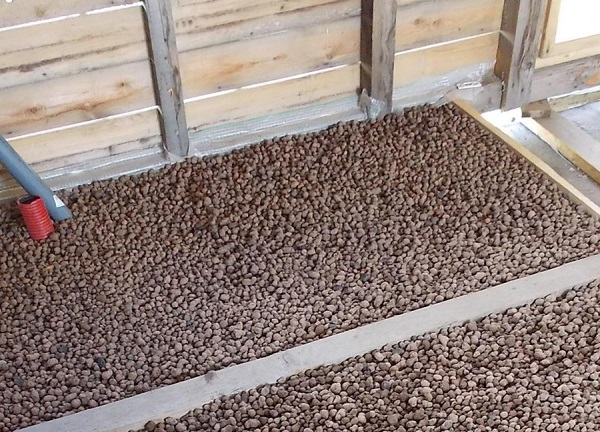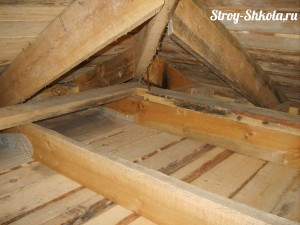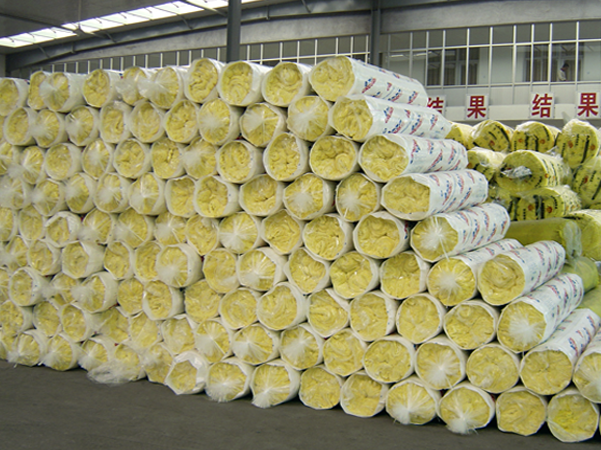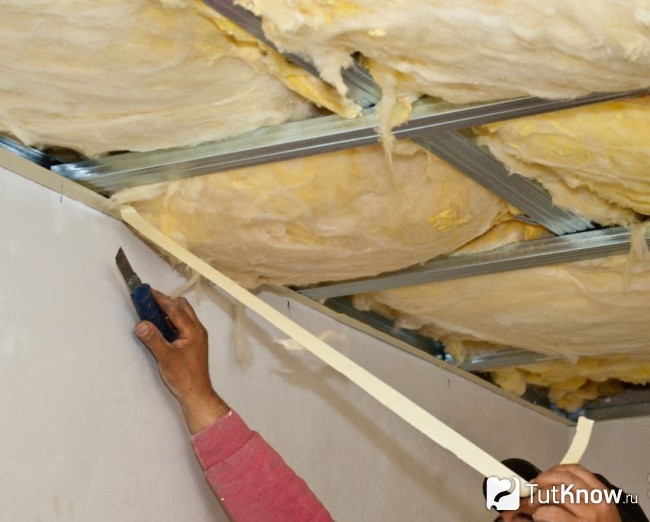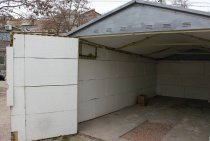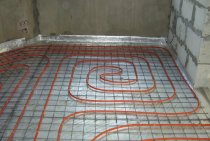Internal insulation
The need for internal insulation of the ceiling is most typical for houses with several floors or with an attic, as well as for city apartments. The entire scope of work consists of the following stages:
- Ceiling lathing - can be made of boards with a section of 30-40 x 100-200 mm (the width of the board directly depends on the thickness of the insulation layer) or a metal profile. The crate is attached to the ceiling with nails or self-tapping screws, while the distance between adjacent parts should be about 50-60 cm, depending on the width of the mineral wool used.
Ceiling trim
A layer of waterproofing is attached to the finished crate - strips 50-60 cm wide are cut out, plus a tolerance of 5 cm on each side, i.e. the total width will be 60-70 cm. These strips are fastened with counter-rails to a wooden crate or with self-tapping screws to the profile.
Next, mineral wool is laid and fixed with glue or a construction stapler to the ceiling, with a large layer thickness - to the crate.
Fastening mineral wool to the ceiling
The next layer is a vapor barrier using glassine. It is mounted on mineral wool using a stapler.
The finished structure is fixed by transverse fixation of the counter-rails or profile.
We fix mineral wool to the ceiling
The procedure for internal insulation is completed, the next step is installation on the crate of drywall, panels or stretch ceiling.
Lamps and mineral wool
Wooden beams can only be used dry, otherwise the wet beam will warp, which will lead to a violation of the false ceiling. Suspensions, self-tapping screws, dowels, insulation, a vapor barrier - a special polypropylene membrane are also purchased. In this case, only special ones can be used - small and closed structures that do not require cooling from above. Since they will be covered with a layer of insulation and will not be ventilated.

Overhead lamps or a chandelier in the middle of the room can also be used, which can be hung on a pin mounted in the ceiling.
The position of the fixtures is planned in advance, the electrical wiring is being prepared. It will be attached in a special shell over the bars in the insulation layer.
When working with glass wool overhead, it is extremely important to observe safety precautions. It is recommended to work only in respirators, goggles, gloves and in a tight headgear and clothing that excludes glass wool from getting on the body

After completion of work, the room should be cleaned with a vacuum cleaner and wet.
Tips from an experienced master
When planning self-insulation of ceilings in a wooden house, it should be understood that this is a difficult and time-consuming process. Before starting any work, you need to carefully think over, calculate and check everything. Little things that sometimes seem insignificant can greatly spoil your nerves and mood in the future.
So, ceiling insulation in a wooden house can be carried out only when all construction and repair work is completed.
Before starting insulation work, you should carefully check the wooden house for tightness and eliminate all distortions and cracks. If you are too lazy and leave some imperfections, then in the future you can be very sorry, because it is through them that the heat will leave the house.
If there is an attic floor, the ceiling can be insulated with one layer of insulating material, but the attic itself will need to be insulated.
Fine finishing can be done on the insulation, but to make it better, it is still better to cover the insulation with boards or plywood sheets.
Rules for insulating the ceiling with mineral wool
With any method, certain rules must be observed:
- in a cold attic, the thickness of the insulation should be at least 300 mm;
- installation of vapor barrier and insulation must be carried out carefully and accurately;
- mineral wool should not shrink during use: it should not be pressed tightly with OSB plates or slag should be poured on top;
- to ensure good sound insulation, mineral wool must have a high density;
- laying a vapor barrier film is mandatory for any type of mineral wool;
- vapor barrier is carried out from the warm side of the room below the insulation;
- vapor barrier film is installed on one side only.
Why the choice fell on mineral wool
Mineral wool in slabs
When choosing insulation for a residential building, first of all, you need to be guided by the fact that it is durable, environmentally friendly and fire resistant. It is mineral wool that most fully meets all these requirements (for example, Rockwool insulation), and therefore is ideal for insulating loggias, floors, walls and ceilings.
Below are its main advantages:
- mineral wool is an environmentally friendly material that does not emit any harmful substances;
- has excellent resistance to fire;
- it has excellent heat and sound insulation properties;
- not subject to decay;
- rodents and insects do not start in it;
- Mineral wool is a cheap insulation. the price of this heat-insulating material is very attractive, which makes it affordable for all categories of citizens.
Of course, there are also disadvantages. The most significant of them is that mineral wool absorbs a lot of moisture. And if the insulation gets wet, it will lose its basic qualities.
Therefore, it all depends on the correct installation. Few people know that with improper installation for a year, mineral wool loses about 40% of its thermal insulation properties.
Rockwool insulation), and therefore ideal for insulating loggias, floors, walls and ceilings.
Below are its main advantages:
- mineral wool is an environmentally friendly material that does not emit any harmful substances;
- has excellent resistance to fire;
- it has excellent heat and sound insulation properties;
- not subject to decay;
- rodents and insects do not start in it;
- Mineral wool is a cheap insulation. the price of this heat-insulating material is very attractive, which makes it affordable for all categories of citizens.
Of course, there are also disadvantages. The most significant of them is that mineral wool absorbs a lot of moisture. And if the insulation gets wet, it will lose its basic qualities.
Therefore, it all depends on the correct installation. Few people know that with improper installation for a year, mineral wool loses about 40% of its thermal insulation properties.
After unpacking, the mineral insulation will restore its volumetric shape.
Advice! Armed with such a device as a thermal imager, you can easily determine whether the insulation has been done correctly, whether the mineral wool has sagged. If it nevertheless lost its properties, then all losses will be displayed in red on the device.
As for the required thickness of the mineral insulation, it differs for apartments and private houses. For a ceiling in a private house, a layer of mineral wool should be at least 15 cm. For apartments, a five-centimeter heat insulator will be enough, but with a higher density.
Advantages and disadvantages of mineral wool ceiling insulation
Due to the large number of positive qualities of mineral wool on the ceiling, it is an excellent solution for residential and non-residential premises. Let's consider its advantages in more detail:
- Almost complete absence of flammability.
The low price is one of the main advantages of this material.
Cotton wool is one of the environmentally friendly and safe heat insulators.
Not attractive to various domestic rodents and insects.
Not subject to decay and mold.
Differs in long warranty period of operation.
Excellent strength combined with the ability to withstand physical stress.
The main weak point of mineral wool is its ability to lose thermal insulation characteristics due to moisture absorption.
Therefore, it is extremely important to follow the rules of ceiling insulation. Otherwise, losses of up to 40-50% of heat in the room are possible.
Over time, the material may sag, especially in the corners, so the wool should be placed in the crate with a small margin.
How to insulate the ceiling with mineral wool
- Additional materials and necessary tools
- Stages of work (external insulation)
- Stages of work (internal insulation)
To retain heat in a house or apartment on the upper floors, the ceiling must be properly insulated. This will reduce the cost of heating the room. According to the laws of physics, warm air flows rise, and if the ceiling is not insulated, then the heat will leave the room. Not every person knows how to insulate the ceiling correctly. Surely for many, when such a problem arose, the question of the need to select the material and the stages of work popped up. The article will discuss how to insulate the ceiling with mineral wool.
To retain heat in a house or apartment on the upper floors, the ceiling must be properly insulated with mineral wool.
In order to properly insulate the ceiling, before starting work, you need to choose the method of insulation (there are three of them: internal insulation, external insulation and combined) and calculate the required amount of material.
This is necessary so that you do not have to stop the insulation of the ceiling due to the purchase of the missing mineral wool or waterproofing film. Or, conversely, spend money on extra material.
There are three types of ceiling insulation: internal insulation, external insulation and combined.
You can calculate the required amount of mineral wool on the ceiling based on SNiP 23-02-2003 “Thermal protection of buildings”. For each climatic zone, the insulation will have its own thickness. Usually it is in the range of 10-15 cm.
People confuse mineral wool with glass wool. A good property of mineral wool is its fire safety, it does not support combustion and does not create smoke. In contrast, glass wool is considered dangerous.
Mineral wool is produced in rolls and mats. There is no fundamental difference. For example, if you have a mansard roof ceiling, then it is better to use mats for mounting convenience. They are good for warming up a room.
Ceiling insulation with expanded clay
Expanded clay is a bulk heat-insulating material, which is a stone made of baked clay with a porous structure. It is very popular as a floor insulation, but it is also suitable for ceilings if they are insulated externally. The thermal conductivity of expanded clay is 0.18 W / (mK). Due to its composition, this insulation does not burn, does not smolder or melt, does not emit harmful substances into the air and is unattractive to fungus or mice.
But at the same time, expanded clay is inferior in terms of thermal insulation properties to foam plastic or mineral wool, and, moreover, it is a very dense and heavy material, therefore it can only be used for fairly strong ceilings with support beams.
Insulation of the ceiling of a private house with expanded clay
The technology for insulating the ceiling with expanded clay is as follows.
- The attic floor and ceiling beams are covered with a vapor barrier film. Instead of a film, you can use ordinary thick polyethylene.
- The space between the beams is covered with expanded clay. It is advisable to mix the insulation of different fractions so that shrinkage is less. The minimum allowable layer thickness is 200 mm, for regions with a cold climate - 400-500 mm.
- Expanded clay is carefully leveled. For this, if necessary, you can even use a simple rake.
Filled expanded clay must be carefully leveled
A second layer of vapor barrier is laid on top of the insulation.
The final step will be laying the floor from boards or plywood.
An alternative to expanded clay among bulk heat insulators can be foam glass, also often called foam crumb. Its thermal conductivity is 0.08 W / (mK), which is more than two times less than expanded clay (recall that in the case of insulation, the lower this indicator, the better).
Before laying the insulation, it is recommended to remove old finishing coatings from the ceiling. If there are traces of mold or fungus on the base, they must be removed. After that, the ceiling should be finished with soil.
The frame for laying the heat insulator can be made by hand. However, you first need to mark the ceiling base. Few ceilings have unsurpassed horizontality, so it is necessary to measure the distance from floor to ceiling in several places. The smallest value should be taken as the basis.
Next, you need to make marks on the ceilings and connect them with a line, constantly monitoring the horizontal position. Following the guidelines, it is necessary to fasten the bars or metal profiles. If the walls are made of wood, then you need to fix the parts on self-tapping screws. If the floors are denser, for example, concrete, then the frame can be fixed using dowels.
How to lay insulation on the ceiling step by step instructions
So, we warm with our own hands the inside of the attic with mineral wool in a private house.
The sequence of actions when laying insulation on the ceiling is as follows:
- First of all, a diagram of the distances between the ceiling rafters is drawn up;
- Next, a diagram of the width of the mineral wool is drawn up, we measure the insulation along the width of the ceiling with a slight overlap;
- The insulation is laid among the rafters, make sure that it does not fall out;
- Distribute the insulating material tightly between the rafters;
- Next, you need to carefully seal the insulation to prevent the appearance of cold and draft;
- Fix the material with dowels;
- It is also necessary to lay and fix sheets of thermal insulation, fill the gaps with mounting foam;
- Prepare the ceiling with insulation to attach drywall;
- Sheathe the space with drywall.
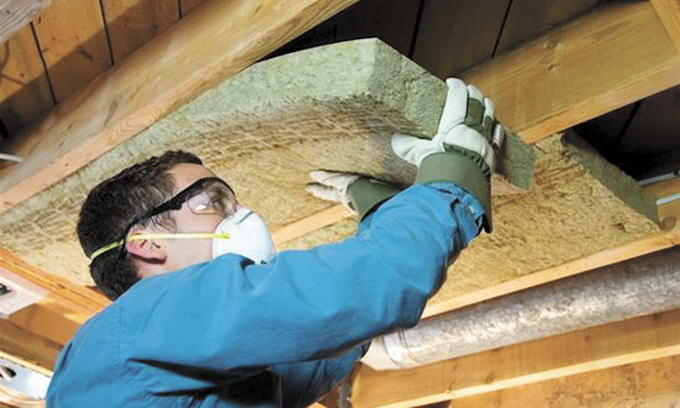
Remember that the laying of the insulating material must be tight to prevent the appearance of cold in the room.
Laying insulation material outside is advisable if the room has low ceilings. In this case, preparation is first made: the attic is cleaned of debris, all joints are carefully sealed with tape. The fixing of the insulation is basically the same, lay the material between the wooden beams and treat all the cracks with mounting foam. The advantage of the external insulation method is that the final processing of the ceiling with plasterboard is not required. If you often use the attic, then a floor, for example, made of wood, can be laid on top of the insulating floor.
External insulation
This method is used in private houses with an attic. Compared to the internal, this type of insulation is simpler to perform and takes much less time and effort. So:
- The entire attic area is covered with a layer of vapor barrier material (glassine) with an overlap of 5-10 cm wide, the joints are glued with adhesive tape or adhesive tape.
- From boards with a section of 30-40 x 100-200 mm (the width, as with internal insulation, depends on the thickness of the mineral wool layer), the crate is stuffed. The distance between adjacent beams is calculated according to the width of the roll or insulation boards.
We make a crate (grooves) for laying mineral wool
With external insulation of the ceiling on the vapor barrier layer, it is recommended to lay a foam layer 5 cm thick. Thanks to it, the level of vapor barrier increases significantly.
Laying a layer of foam
Mineral wool is laid on the foam plastic with a layer of 10-20 cm.It is important that when laying between the layers of insulation and the beams of the crate there are no gaps left.
The process of laying mineral wool in the grooves on the roof
If mineral wool is covered with foil on one side, then the flooring is produced so that this part is on top. In this case, an additional layer of waterproofing is not needed. If the mineral wool is ordinary, then it is carefully covered with a layer of waterproofing material with an overlap on top, the joints are glued with adhesive tape or adhesive tape and everything is fixed with counter rails.
Next, the floor is mounted from wooden boards, chipboard or OSB.
Combined insulation
Combined insulation is the installation of mineral wool on the ceiling both from the inside and from the attic. This method of insulation is typical for rooms in which it is necessary to maintain elevated temperatures for a long time - baths, saunas, steam rooms, etc.
In conclusion, a few words should be said about small tricks that will help to avoid numerous problems after insulating the ceiling with mineral wool:
- · The fine fibers that make up mineral wool cause itching and irritation when they come into contact with exposed skin and in the respiratory tract. To avoid causing harm to health, it is necessary to use special clothing and a respirator.
- · When using a crate made of a metal profile, it may subsequently turn out that cold air continues to flow through the ceiling through the corners. To eliminate the occurrence of such a problem, after fixing the metal profile to the ceiling, all corners are carefully filled with mounting foam.
- · Due to calculation errors, the thickness of the mineral wool layer may exceed the width of the crate. In this case, additional bars are nailed to the wooden beams. If the crate is made of a metal profile, you will have to replace the suspensions or reduce the insulation layer.
- · When laying mineral wool, it is strictly forbidden to compact and press it - this leads to a decrease in the number of air bubbles inside the insulation and, as a result, the loss of thermal insulation properties.
- · In places where spotlights are installed, it is necessary to provide space for air circulation in order to avoid subsequent problems with their constant burnout.
- · The most suitable for fixing a metal profile are hardened steel self-tapping screws.
- You can determine the current state of the insulated ceiling using a device such as a thermal imager. In the on state, the screen indicates the places where cold air passes through in red.
- All of the above is designed to maximally facilitate and optimize the financial and physical costs of insulating the ceiling with mineral wool. However, to obtain the best result, you should seek the advice of specialists. It is they who will help to make the correct calculations of the required thickness of the insulation layer and, based on this, calculate the final amount of material and its cost. Often, such firms directly cooperate with manufacturers of materials for insulation, which can result in additional savings on purchase.
Video - Insulation of the ceiling with mineral wool
- Wall insulation with mineral wool
- Insulation of a frame house with basalt wool
- Insulation of a wooden house from the outside
- How to insulate a bath from the inside
Main characteristics of the material
Mineral wool. Click on the photo to enlarge.
The main advantage of mineral wool insulation is its cost. The low price made the material in demand and popular. Mineral wool is not exposed to rotting and burning, pests and insects do not start in it. It is possible to properly insulate the room with the help of this material, observing all the installation and installation technologies.
The disadvantages of mineral wool are excessive moisture absorption.When wet, the material loses its basic properties. Few professionals know that improper installation of the insulating layer to the ceiling will lead to an early loss of 40% of the operational properties of the material.
The correctness of the laying of the heat-insulating layer is determined using a thermal imager, which shows the subsidence of the material and its overlay. The device displays all losses in red if it detects problems with mineral wool. It is worth remembering that often the presence of drafts emanating from window structures affects the level of this indicator. There are several reasons for heat loss:
- lack of adhesion (gaps between layers);
- insulation drawdown;
- metal crate in places of ceiling insulation.
Features of thermal insulation of the ceiling with mineral wool
The class of mineral wool, according to the standards, includes several varieties of this material: made on the basis of glass, slag, and stone wool. Each type differs from the other in the length and thickness of the fibers, as well as in technical parameters.
One of the best is basalt wool, which does not contain binders. It can withstand temperatures up to 1000 degrees and is successfully used in thermal insulation works in baths and saunas.
There are several major manufacturers of mineral wool in the modern building materials market. Among them are such brands as ISOVER, Rockwoll, URSA, PAROC and others. German materials are considered the best, which undergo serious European certification, but they also cost an order of magnitude more expensive. The cost of insulation is also affected by its density. This is related to the volume of starting material that is required for the manufacturing process.
When buying mineral wool, it will be useful to make sure that it is produced in accordance with the requirements of GOSTs. Check with the seller exactly how the fibers of this material are located. Their vertical arrangement will indicate that such an insulator retains heat well and protects against extraneous noise. On the other hand, the chaotic placement of the fibers increases the strength of the wool and improves its performance.
On sale there are different forms of this heat insulator, which can be packaged in two main ways. The thickness of the mineral wool for ceiling insulation also affects the shape of its release. Relatively thin material (up to 50 mm) is sold in rolls, which are unwound at the facility and cut into the necessary pieces with a knife. Thicker wool, which can reach 10 cm or more, is usually available in the form of mats and is placed in a space.
A waterproofing layer must be present directly under the roof. If this is not done, then during the winter months, moisture will begin to collect on the inside cold surface of the roof. It is waterproofing that serves as a barrier that will protect the ceiling from blackening and decay. In addition, in the gap between the roof and waterproofing, you need to leave a space 2-3 cm high, which will act as ventilation.
Insulation work can be carried out in various ways. In apartments, cotton wool is placed between the main and stretch ceilings, in private houses, thermal insulation is carried out in the attic.
There are a number of rules that will help even an inexperienced master to make the insulation of the ceiling with mineral wool more effective:
When installing several different heaters, it is desirable to arrange them in such a way that the vapor permeability increases from the bottom to the top.
With internal insulation from the side of the room, a vapor barrier film is necessarily laid, which will protect the mineral wool from getting wet and destroyed.
In cold attics, the thickness of the heat insulator should be at least 300 mm. This indicator will affect not only the preservation of heat, but also the prevention of condensation.
Vapor barrier should not be laid on either side of the insulation, as this will clog moisture inside it.
If the plates are not overlapped, then the joints must be treated with mounting foam.
When installing mineral wool, it is forbidden to tamp it, because this can provoke a decrease in the number of air bubbles inside and an automatic deterioration in thermal insulation qualities.
Note! When working with this heater, you must follow the safety rules. Cotton wool contains the finest fibers that can cause itching and irritation if it gets on the open skin or, even worse, in the respiratory tract. To avoid this, when warming, you need to use tight gloves, wear protective clothing, a respirator
To avoid this, when warming, you need to use tight gloves, wear protective clothing, a respirator.
Insulation options and choice of materials
There are two ways to insulate the ceiling in the house:
When choosing internal insulation, you should be prepared for the fact that the height of the ceiling will be significantly reduced. If you insulate the ceiling with a heater on the attic floor, then after laying it you need to make a floor covering.
To insulate the ceiling, you can use:
- sawdust; mineral wool; penofol; clay; polyurethane foam; polystyrene foam (polystyrene).
When choosing a material for thermal insulation, it should be remembered that it must have good thermal insulation properties. In addition, dust and other substances harmful to health should not come from it. And it must be safe in case of fire.
Features in creation
There must be reliable insulation of the room from mineral wool so that harmful microfibers do not enter the living space. The role of such an insulator is assumed by the vapor barrier, which must be especially careful at the intersection of cables and pipes. It is advisable to use glass wool grades that do not contain phenolic binders.
Resins are used to stiffen boards. To insulate the ceiling from the inside, pure glass wool is suitable. The layer of mineral wool (glass wool) must be of sufficient thickness so that the insulation is made in accordance with economic feasibility and ensures comfort inside. The ceiling is the main place of heat leakage from the house, it is known that for a temperate climate, a layer of mineral wool should be at least 20 cm thick.
Now it remains to implement all this - to make a classic false ceiling, and fill the space between it and the ceiling with insulation.
